Popular categories
Looking for a yarn?

53% Cotton, 33% Viscose, 14% Linen
from 2.20 € /50g
Order DROPS Belle from Wool Warehouse Direct Ltd

|
DROPS Belle uni colour 53% Cotton, 33% Viscose, 14% Linen |
2.20 € /50g |
Order |
Clicking the ORDER button will redirect you to Wool Warehouse Direct Ltd website
Order DROPS Needles & Hooks
Clicking the ORDER button will redirect you to Wool Warehouse Direct Ltd website
The yarn cost is calculated from the pattern’s smallest size and the yarn’s cheapest product type. Looking for an even better price? You might find it on the DROPS Deals!
Sentinel
Knitted DROPS men’s jumper with cables and raglan in Belle. Size: S - XXXL.
DROPS design: Pattern no vs-030
Yarn group B
----------------------------------------------------------
Size: S - M - L - XL - XXL - XXXL
Materials:
DROPS BELLE from Garnstudio
500-550-600-650-750-800 g colour no 06, silver
DROPS DOUBLE POINTED NEEDLES AND CIRCULAR NEEDLE (40 and 80 cm) SIZE 4 mm - or size needed to get 21 sts x 28 rows in stocking st = 10 x 10 cm.
DROPS DOUBLE POINTED NEEDLES AND CIRCULAR NEEDLE (80 cm) SIZE 3.5 mm for rib - or size needed to get 22 sts x 30 rows in stocking st = 10 x 10 cm.
----------------------------------------------------------
-------------------------------------------------------
Alternative Yarn – See how to change yarns here
Yarn Groups A to F – Use the same pattern and change the yarn here
Yarn usage using an alternative yarn – Use our yarn converter here
-------------------------------------------------------

53% Cotton, 33% Viscose, 14% Linen
from 2.20 € /50g
Order DROPS Belle from Wool Warehouse Direct Ltd

|
DROPS Belle uni colour 53% Cotton, 33% Viscose, 14% Linen 2.20 € /50g Order |
Clicking the ORDER button will redirect you to Wool Warehouse Direct Ltd website
Order DROPS Needles & Hooks
Clicking the ORDER button will redirect you to Wool Warehouse Direct Ltd website
The yarn cost is calculated from the pattern’s smallest size and the yarn’s cheapest product type. Looking for an even better price? You might find it on the DROPS Deals!
- English (UK/cm)
- Česky - not translated
- Dansk
- Deutsch
- Eesti keel
- English (UK/cm)
- English (US/in)
- Español
- Français
- Íslenska
- Italiano
- Magyar
- Nederlands
- Norsk
- Polski
- Português
- Suomi
- Svenska
- English (UK/cm), Bulgaria
- English (UK/cm), Croatia
- English (UK/cm), Greece
- English (UK/cm), Latvia
- English (UK/cm), Lithuania
- English (UK/cm), Romania
- English (UK/cm), Slovenia
- Česky, Slovakia - not translated
Pattern instructions
* K 1 round and P 1 round *, repeat from *-*. 1 ridge = 2 rounds.
PATTERN:
See diagrams A.1 to A.4.
RAGLAN:
Dec 2 sts in every transition between body and sleeves.
Dec as follows from RS:
Beg 3 sts before marker and work as follows: K 2 tog, K 2 (marker is between these 2 sts), slip 1 st as if to K, K 1, psso.
----------------------------------------------------------
JUMPER:
Worked in the round on circular needle.
BODY:
Cast on 192-216-240-264-288-312 sts on circular needle size 3.5 mm with Belle. K 1 round, on next round work A.1 (= 12 sts) over all sts (16-18-20-22-24-26 repetitions). When A.1 has been worked 1 time vertically, switch to circular needle size 4 mm and continue with A.2 over A.1. REMEMBER THE KNITTING TENSION When piece measures 44-45-46-47-48-49 cm, cast off for armholes in each side as follows: Work the first 87-99-111-123-135-147 sts (= front piece), cast off the next 9 sts (= P 2 + K 5 + P 2), work the next 87-99-111-123-135-147 sts (= back piece), cast off the last 9 sts. Put piece aside and knit the sleeves.
SLEEVE:
Worked in the round on double pointed needles. Cast on 52-52-56-56-60-60 sts on double pointed needle size 3.5 mm with Belle. Insert 1 marker at the beg of round. K 1 round, then work as follows:
Size S + M + XXL + XXXL:
K 1, * P 2, K 2 *, repeat from *-* over the next 16-16-20-20 sts, A.3 (= 18 sts), * K 2, P 2 *, repeat from *-* over the next 16-16-20-20 sts, finish with K 1.
Size L + XL:
P 1, K 2, * P 2, K 2 *, repeat from *-* over the next 16-16 sts, A.3 (= 18 sts), * K 2, P 2 *, repeat from *-* over the next 16-16 sts, finish with K 2 and P 1.
When A.3 has been worked, there are 53-53-57-57-61-61 sts on round. Switch to double pointed needles size 4 mm. Continue as follows: Stocking st over the first 17-17-19-19-21-21 sts, AT THE SAME TIME dec 1-0-1-0-1-0 sts evenly, A.4 over A.3, stocking st over the next 17-17-19-19-21-21 sts, AT THE SAME TIME dec 1-0-1-0-1-0 sts evenly = 51-53-55-57-59-61 sts. Continue with stocking st and A.4. When piece measures 8 cm, inc 1 st on each side of marker. Inc every 3½-3-2½-2½-2-2 cm 10-12-13-14-20-21 times in total, then every 2 cm 5-5-5-5-0-0 times = 81-87-91-95-99-103 sts. Work inc sts in stocking st. When piece measures 55-55-54-53-52-52 cm (NOTE! Shorter measurements in the larger sizes because of longer raglan dec and larger neck width) cast off the 4 sts on each side of marker = 73-79-83-87-91-95 sts. Put piece aside and knit another sleeve.
YOKE:
Slip sleeves on to same circular needle as body where armholes were cast off = 320-356-388-420-452-484 sts. Insert 1 marker in all transitions between sleeves and body (= 4 markers). Continue with pattern over sts on body and pattern and in stocking st as before on sleeves, AT THE SAME TIME on next round beg dec for RAGLAN – see explanation above (= 8 sts dec). Repeat dec on every other round 21-21-22-23-24-25 more times and then on every round 2-5-6-7-8-9 times. After all dec for raglan 128-140-156-172-188-204 sts remain on round. Work 1 ridge in GARTER ST - see explanation above AT THE SAME TIME on first round dec 12-20-32-44-56-68 sts evenly = 116-120-124-128-132-136 sts. Work rib K 2/P 2, cast off with K over K and P over P when rib measures approx. 3 cm.
ASSEMBLY:
Sew the opening under the sleeves.
This pattern has been corrected. Click here to see the correction/s.
Correction: Diagrams A.2 and A.4 have been edited. Symbol for no stitch was missing.
Diagram

|
= knit |

|
= purl |

|
= 1 yarn over between 2 st, on next round work the yarn over twisted to avoid making a hole |

|
= 1 yarn over between 2 sts, on next round knit the yarn over to make a hole |

|
= knit 2 sts tog |

|
= slip 1 st knitwise, k 2 and pass the slipped st over |

|
= no stitch |

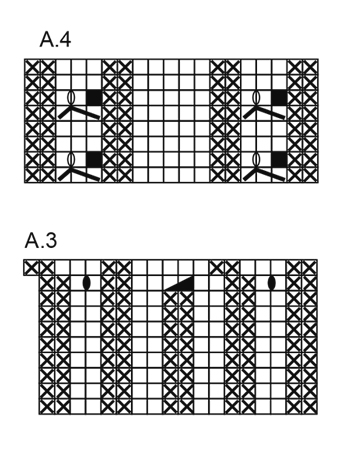
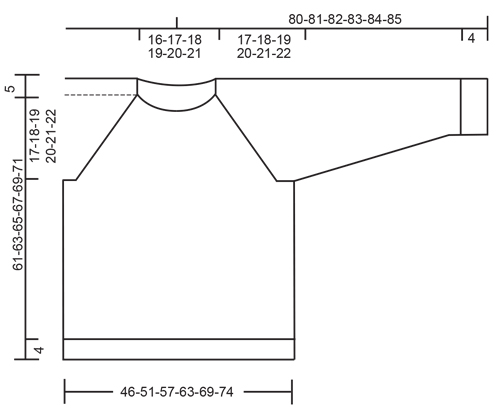
What can you do with our patterns? You can share DROPS patterns online, using the pattern original picture, materials, name and number. But you are NOT ALLOWED to reproduce the complete pattern digitally in any way. Yarn stores are welcome to use the DROPS pattern database to promote the sale of our assortment. You can print out our patterns, make as many copies as you’d like. The only thing we ask is that you don't make any changes / additions to the original printed document. And that the patterns according to the DROPS philosophy are given out to the consumers for free. Editorials that wish to publish our patterns in printed books or magazines can contact us for more information. The sale of garments based on DROPS patterns is permitted as long as they are sold as single items or per order. Further commercial use of the patterns is not permitted. It has to be clearly stated that the garment is made based on a design from DROPS DESIGN. The use of clothing labels of which DROPS DESIGN forms part is conditioned by the inclusion of the following text: “A DROPS DESIGN made by …..”. The use of DROPS photos for marketing purposes/sales is only permitted in connection with the use/sale of DROPS products. The photos may not be cut or edited and the logo should be clearly visible.
We reserve the right to withdraw the permission for use of our patterns at any time, notwithstanding the reason.
Each of our patterns has specific tutorial videos to help you.
These step-by-step tutorials might also help you:
Why is the knitting/crochet tension so important?
Knitting tension is what determines the final measurements of your work, and is usually measured per 10 x 10 cm. It is provided like so: number of stitches in width x number of rows in height - eg: 19 stitches x 26 rows = 10 x 10 cm.
The knitting tension is very individual; some people knit/crochet loosely while others work tightly. You adjust the knitting tension with the needle size, which is why the suggested needle size is only meant as a guide! You need to adjust this (up or down) to ensure that YOUR knitting tension matches the knitting tension provided in the pattern. If you work with a different knitting tension than provided you will have a different yarn consumption, and your work will have different measurements than what the pattern suggests.
The knitting tension also determines which yarns can replace each other. As long as you achieve the same knitting tension you can replace one yarn with another.
See DROPS lesson: How to measure your tension/gauge
See DROPS video: How to make a gauge tension swatch
How do I know how many balls of yarn I need?
The required amount of yarn is provided in grams, eg: 450 g. To calculate how many balls you’ll need you first need to know how many grams are in 1 ball (25g, 50g or 100g). This information is available if you click on the individual yarn quality on our pages. Divide the amount required with the amount of each ball. For example, if each ball is 50g (the most common amount), the calculation will be as follows: 450 / 50 = 9 balls.
Can I use a different yarn than what the pattern suggests?
The important thing when changing from one yarn to another is that the knitting/crochet tension remains the same. This is so that the measurements of the finished piece will be the same as on the sketch provided. It is easier to achieve the same knitting tension using yarns from the same yarn group. It is also possible to work with multiple strands of a thinner yarn to achieve the knitting tension of a thicker one. Please try our yarn converter. We recommend you to always work a test swatch.
Please NOTE: when changing yarn the garment might have a different look and feel to the garment in the photo, due to individual properties and qualities of each yarn.
See DROPS lesson: Can I use a different yarn than the one mentioned in the pattern?
What are the yarn groups?
All our yarns are categorised into yarn groups (from A to F) according to thickness and knitting tension – group A contains the thinnest yarns and group F the thickest. This makes it easier for you to find alternative yarns to our patterns, should you wish to switch yarn. All yarns within the same group have a similar knitting tension and can easily replace each other. However, different yarn qualities have different structures and properties which will give the finished work a unique look and feel.
How do I use the yarn calculator?
At the top of all our patterns you’ll find a link to our yarn calculator, which is a helpful tool should you wish to use a different yarn than suggested. By filling in the yarn quality you wish to replace, the amount (in your size) and number of strands, the calculator will present good alternative yarns with the same knitting tension. Additionally it will tell you how much you’ll require in the new qualities and whether you’ll need to work with multiple strands. Most skeins are 50g (some are 25g or 100g).
If the pattern is worked with multiple colours, every colour will have to be calculated separately. Similarly, if the pattern is worked with several strands of different yarns (for example 1 strand Alpaca and 1 strand Kid-Silk) you will have to find alternatives for each, individually.
Why do you show discontinued yarns in the patterns?
Since different yarns have different qualities and textures we have chosen to keep the original yarn in our patterns. However, you can easily find options among our available qualities by using our yarn calculator, or simply pick a yarn from the same yarn group.
It is possible that some retailers still have discontinued yarns in stock, or that someone has a few skeins at home that they would like to find patterns for.
The yarn calculator will provide both alternative yarn as well as required amount in the new quality.
What size should I knit?
If you think it's hard to decide what size to make, it can be a good idea to measure a garment you own already and like the size of. Then you can pick the size by comparing those measures with the ones available in the pattern's size chart.
You'll find the size chart at the bottom of the pattern.
See DROPS lesson: How to read size chart
Why do I get the wrong knitting tension with the suggested needle size?
The needle size provided in the pattern serves only as a guide, the important thing is to follow the knitting tension. And since knitting tension is very individual, you will have to adjust the needle size to ensure that YOUR tension is the same as in the pattern – maybe you’ll have to adjust 1, or even 2 needle sizes, up or down to achieve the correct tension. For this, we recommend that you work test swatches.
Should you work with a different knitting tension than the one provided, the measurements of the finished garment might deviate from the measurement sketch.
See DROPS lesson: How to measure your tension/gauge
See DROPS video: How to make a tension/gauge swatch
Why is the pattern worked top-down?
Working a garment top-down provides more flexibility and room for personal adjustment. For example it is easier to try the garment on while working, as well as making adjustments to length of yoke and shoulder caps.
The instructions are carefully explaining every step, in the correct order. Diagrams are adjusted to the knitting direction and are worked as usual.
How do I work according to a knitting diagram?
The diagram depicts all rows/rounds, and every stitch seen from the right side. It is read from bottom to top, from right to left. 1 square = 1 stitch.
When working back and forth, every other row is worked from the right side and every other row is worked from the wrong side. When working from the wrong side, the diagram will have to be worked reversed: from left to right, knit stitches are purled, purl stitches are knit etc.
When working in the round every round is worked from the right side and the diagram are worked from right to left on all rounds.
See DROPS lesson: How to read knitting diagrams
How do I work according to a crochet diagram?
The diagram depicts all rows/rounds, and every stitch seen from the right side. It is worked from bottom to top, from right to left.
When working back and forth every other row is worked from the right side: from right to left and every other row is worked from the wrong side: from left to right.
When working in the round, every row in the diagram are worked from the right side, from right to left.
When working a circular diagram you start in the middle and work your way outwards, counter clockwise, row by row.
The rows usually start with a given number of chain stitches (equivalent to the height of the following stitch), this will either be depicted in the diagram or explained in the pattern.
See DROPS lesson: How to read crochet diagrams
How do I work several diagrams simultaneously on the same row/round?
Instructions for working several diagrams after each other on the same row/round, will often be written like so: “work A.1, A.2, A.3 a total of 0-0-2-3-4 times". This means you work A.1 once, then A.2 is worked once, and A.3 is repeated (in width) the number of times provided for your size – in this case like so: S = 0 times, M = 0 times, L=2 times, XL= 3 times and XXL = 4 times.
The diagrams are worked as usual: begin with the first row in A.1, then work the first row in A.2 etc.
See DROPS lesson: How to read knitting diagrams
See DROPS lesson: How to read crochet diagrams
Why are the sleeves shorter in larger sizes?
The total width of the garment (from wrist-to-wrist) will be larger in the larger sizes, despite the actual sleeves being shorter. The larger sizes have longer sleeve caps and wider shoulders, so there will be a good fit in all sizes.
Where on the garment is the length measured?
The measurement sketch/schematic drawing provides information regarding the full length of the garment. If it’s a jumper or a jacket the length is measured from the highest point on the shoulder closest to the neckline, and straight down to the bottom of the garment. It is NOT measured from the tip of shoulder. Similarly, the length of yoke is measured from the highest point on the shoulder and down to where yoke is split into body and sleeves.
On a jacket measures are never taken along bands, unless specifically stated. Always measure inside band stitches when measuring the length.
See DROPS lesson: How to read a schematic drawing
What is a repeat?
Diagrams are often repeated on the round or in height. 1 repeat is the diagram the way it appears in the pattern. If it says to work 5 repeats of A.1 in the round, then you work A.1 a total of 5 times after/next to each other in the round. If it says to work 2 repeats of A.1 vertically/in height you work the entire diagram once, then begin again at the start and work the entire diagram one more time.
Why does the piece start with more chain stitches than it’s worked with?
Chain stitches are slightly narrower than other stitches and to avoid working the cast-on edge too tight, we simply chain more stitches to begin with. The stitch count will be adjusted on the following row to fit the pattern and measurement sketch.
Why increase before the rib edge when the piece is worked top-down?
The rib edge is more elastic and will contract slightly compared to, for example, stocking stitch. By increasing before the rib edge, you avoid a visible difference in width between the rib edge and the rest of the body.
Why increase in the cast-off edge?
It’s very easy to cast off too tightly, and by making yarn overs while casting off (and simultaneously casting these off) you avoid a too tight cast off edge.
See DROPS video: How to bind off with yarn overs (yo)
How do I increase/decrease on every 3rd and 4th row/round alternately?
To achieve an even increase (or decrease) you can increase on, for example: every 3rd and 4th row alternately, like so: work 2 rows and increase on the 3rd row, work 3 rows and increase on the 4th. Repeat this until the increase is complete.
See DROPS lesson: Increase or decrease 1 st on every 3rd and 4th row alternately
How can I work a jacket in the round instead of back and forth?
Should you prefer to work in the round instead of back and forth, you may of course adjust the pattern. You’ll need to add steeks mid-front (usually 5 stitches), and follow the instructions. When you would normally turn and work from the wrong side, simply work across the steek and continue in the round. At the end you’ll cut the piece open, pick up stitches to work bands, and cover the cut edges.
See DROPS video: How to knit steeks and cut open
Can I work a jumper back and forth instead of in the round?
Should you prefer to work back and forth instead of in the round, you may of course adjust the pattern so you work the pieces separately and then assemble them at the end. Divide the stitches for the body in 2, add 1 edge stitch in each side (for sewing) and work the front and back pieces separately.
See DROPS lesson: Can I adapt a pattern for circular needles into straight needles?
Why is the pattern slightly different than what I see in the photo?
Pattern repeats can vary slightly in the different sizes, in order to get the correct proportions. If you’re not working the exact same size as the garment in the photo, yours might deviate slightly. This has been carefully developed and adjusted so that the complete impression of the garment is the same in all sizes.
Make sure to follow instructions and diagrams for your size!
How do I make a women’s size garment into a men’s size one?
If you have found a pattern you like which is available in women’s size it’s not very difficult to convert it to men’s size. The biggest difference will be the length of sleeves and body. Start working on the women size that you think would fit across the chest. The additional length will be worked right before you cast off for the armhole/sleeve cap. If the pattern is worked top-down you can add the length right after the armhole or before the first decrease on sleeve.
Regarding additional yarn amount, this will depend on how much length you add, but it is better with a skein too many than too few.
How do I prevent a hairy garment from shedding?
All yarns will have excess fibres (from production) that might come off as lint or shedding. Brushed yarns (ie hairier yarns) have more of these loose, excess fibres, causing more shedding.
Shedding also depends on what is worn under or over the garment, and whether this pulls at the yarn fibres. It’s therefore not possible to guarantee that there will be no shedding
Below are some tips on how to get the best result when working with hairier yarns:
1. When the garment is finished (before you wash it) shake it vigorously so the looser hairs come off. NOTE: do NOT use a lint roller, brush or any method that pulls at the yarn.
2. Place the garment in a plastic bag and put it in your freezer - the temperature will cause the fibres to become less attached to each other, and excess fibres will come off easier.
3. Leave in the freezer for a few hours before taking it out and shaking it again.
4. Wash the garment according to the instructions on the yarn label.
Why does my garment pill?
Pilling is a natural process that happens to even the most exclusive of fibers. It's a natural sign of wear and tear that is hard to avoid, and that is most visible in high friction areas of your garment like a sweater's arms and cuffs.
You can make your garment look as new by removing the pilling, using a fabric comb or a pill/lint remover.
In the meantime, you can read the questions and answers that others have left to this pattern or join the DROPS Workshop on Facebook to get help from fellow knitters/crocheters!
You might also like...
Sentinel
Sentinel
Sentinel
Sentinel & Sentinel-mini
Sentinel |
||||||||||||||||||||||
 |
 |
|||||||||||||||||||||
Knitted DROPS men’s jumper with cables and raglan in Belle. Size: S - XXXL.
DROPS 174-2 |
||||||||||||||||||||||
|
GARTER ST (in the round on circular needle): * K 1 round and P 1 round *, repeat from *-*. 1 ridge = 2 rounds. PATTERN: See diagrams A.1 to A.4. RAGLAN: Dec 2 sts in every transition between body and sleeves. Dec as follows from RS: Beg 3 sts before marker and work as follows: K 2 tog, K 2 (marker is between these 2 sts), slip 1 st as if to K, K 1, psso. ---------------------------------------------------------- JUMPER: Worked in the round on circular needle. BODY: Cast on 192-216-240-264-288-312 sts on circular needle size 3.5 mm with Belle. K 1 round, on next round work A.1 (= 12 sts) over all sts (16-18-20-22-24-26 repetitions). When A.1 has been worked 1 time vertically, switch to circular needle size 4 mm and continue with A.2 over A.1. REMEMBER THE KNITTING TENSION When piece measures 44-45-46-47-48-49 cm, cast off for armholes in each side as follows: Work the first 87-99-111-123-135-147 sts (= front piece), cast off the next 9 sts (= P 2 + K 5 + P 2), work the next 87-99-111-123-135-147 sts (= back piece), cast off the last 9 sts. Put piece aside and knit the sleeves. SLEEVE: Worked in the round on double pointed needles. Cast on 52-52-56-56-60-60 sts on double pointed needle size 3.5 mm with Belle. Insert 1 marker at the beg of round. K 1 round, then work as follows: Size S + M + XXL + XXXL: K 1, * P 2, K 2 *, repeat from *-* over the next 16-16-20-20 sts, A.3 (= 18 sts), * K 2, P 2 *, repeat from *-* over the next 16-16-20-20 sts, finish with K 1. Size L + XL: P 1, K 2, * P 2, K 2 *, repeat from *-* over the next 16-16 sts, A.3 (= 18 sts), * K 2, P 2 *, repeat from *-* over the next 16-16 sts, finish with K 2 and P 1. When A.3 has been worked, there are 53-53-57-57-61-61 sts on round. Switch to double pointed needles size 4 mm. Continue as follows: Stocking st over the first 17-17-19-19-21-21 sts, AT THE SAME TIME dec 1-0-1-0-1-0 sts evenly, A.4 over A.3, stocking st over the next 17-17-19-19-21-21 sts, AT THE SAME TIME dec 1-0-1-0-1-0 sts evenly = 51-53-55-57-59-61 sts. Continue with stocking st and A.4. When piece measures 8 cm, inc 1 st on each side of marker. Inc every 3½-3-2½-2½-2-2 cm 10-12-13-14-20-21 times in total, then every 2 cm 5-5-5-5-0-0 times = 81-87-91-95-99-103 sts. Work inc sts in stocking st. When piece measures 55-55-54-53-52-52 cm (NOTE! Shorter measurements in the larger sizes because of longer raglan dec and larger neck width) cast off the 4 sts on each side of marker = 73-79-83-87-91-95 sts. Put piece aside and knit another sleeve. YOKE: Slip sleeves on to same circular needle as body where armholes were cast off = 320-356-388-420-452-484 sts. Insert 1 marker in all transitions between sleeves and body (= 4 markers). Continue with pattern over sts on body and pattern and in stocking st as before on sleeves, AT THE SAME TIME on next round beg dec for RAGLAN – see explanation above (= 8 sts dec). Repeat dec on every other round 21-21-22-23-24-25 more times and then on every round 2-5-6-7-8-9 times. After all dec for raglan 128-140-156-172-188-204 sts remain on round. Work 1 ridge in GARTER ST - see explanation above AT THE SAME TIME on first round dec 12-20-32-44-56-68 sts evenly = 116-120-124-128-132-136 sts. Work rib K 2/P 2, cast off with K over K and P over P when rib measures approx. 3 cm. ASSEMBLY: Sew the opening under the sleeves. |
||||||||||||||||||||||
Diagram explanations |
||||||||||||||||||||||
|
||||||||||||||||||||||

|
||||||||||||||||||||||

|
||||||||||||||||||||||

|
||||||||||||||||||||||
|
Have you made this or any other of our designs? Tag your pictures in social media with #dropsdesign so we can see them! Do you need help with this pattern?You'll find tutorial videos, a Comments/Questions area and more by visiting the pattern on garnstudio.com. © 1982-2024 DROPS Design A/S. We reserve all rights. This document, including all its sub-sections, has copyrights. Read more about what you can do with our patterns at the bottom of each pattern on our site. |
||||||||||||||||||||||
With over 40 years in knitting and crochet design, DROPS Design offers one of the most extensive collections of free patterns on the internet - translated to 17 languages. As of today we count 304 catalogues and 11422 patterns - 11422 of which are translated into English (UK/cm).
We work hard to bring you the best knitting and crochet have to offer, inspiration and advice as well as great quality yarns at incredible prices! Would you like to use our patterns for other than personal use? You can read what you are allowed to do in the Copyright text at the bottom of all our patterns. Happy crafting!










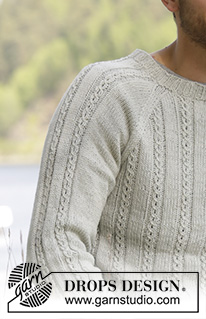


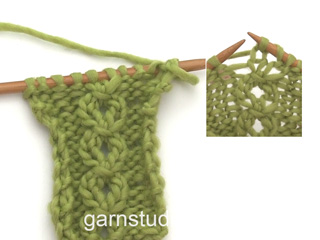







































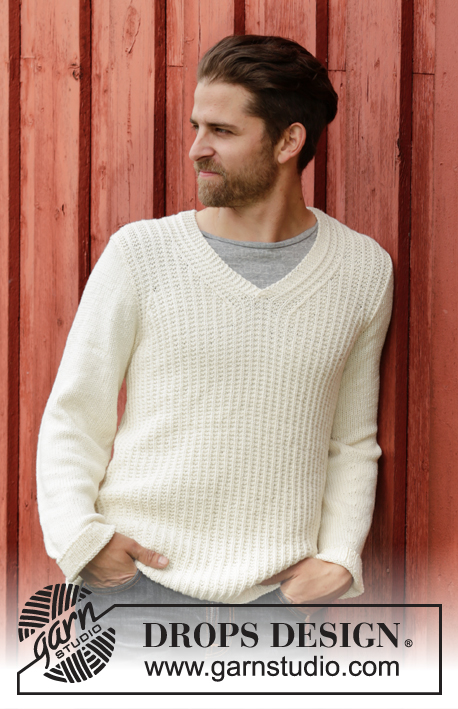
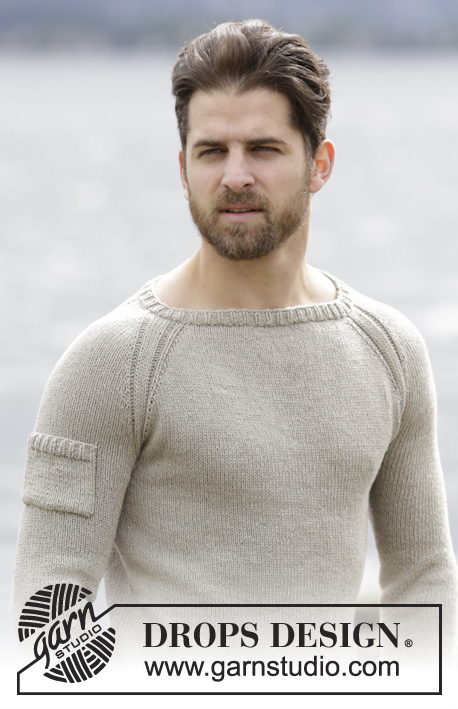


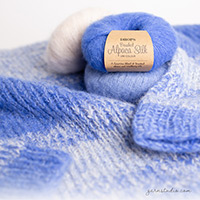



Comments / Questions (41)
So sorry I just realized my mistake. I read the instructions incorrectly. Thank you.
16.04.2022 - 20:20I've read your explanation for A2 and here's the problem. You are decreasing by 2 stitches not one stitch so only one stitch remains. On the next row the yarn over increases by only one stitch. What am I missing? Thank you.
16.04.2022 - 20:09DROPS Design answered:
Dear Lorraine, in row 1, you decrease 1 stitch (from 3 you get 2). In the next row, the black square is not a stitch. Then you work yarn over between 2 stitches, so that you have 3 stitches again in the 3rd row. Happy knitting!
17.04.2022 - 12:09Onko tuos ohjeessa noin paljon virheitä. Vai mikä esittää moin paljon kysymyksiä. Mieli teliki kuntoa tuo malli.
20.01.2022 - 18:12DROPS Design answered:
Hei, ohjeessa ei ole virheitä. Kysymykset koskevat muun muassa puseron joustavuutta ja eri neuletekniikoita.
09.03.2022 - 17:14Jeg strikker i Drops Belle, ja. Og syntes at den virker ret elastisk, men var ikke sikker på at den skulle være tætsiddende eller ej, siden at det ikke var nævnt i opskriften, ligesom det var ved andre sweatre og veste her på siden. Jeg fortsætter og håber på det bedste. Ellers har jeg en ekstra nøgle, hvis jeg nu skal trævle op. Tak for svar!
16.08.2021 - 13:41DROPS Design answered:
Hei Anne Mette. Bare hyggelig, god fornøyelse videre. mvh DROPS design
16.08.2021 - 14:28Jeg har strikket 17 cm af blusen i en størrelse L, men den har indtil videre kun en bredde på 47 cm, når den hviler på pindene. Er det meningen at trøjen skal være tætsiddende og meget elastisk, eller skal jeg gå 1-2 størrelser op for at få min ønskede bredde på 57 cm? Min strikkefasthed passede i både højde og bredde på testlappen.
03.08.2021 - 17:40DROPS Design answered:
He Anne. Når man ser på bildet, syns jeg dette er en tettsittende genser, og mønstret (flettene) gjør det slik at det vil trekke seg litt sammen. Strikker du i DROPS Belle, eller et garn som trekker seg litt mer sammen? mvh DROPS design
16.08.2021 - 13:25Drops Bella kostar 20.95 på beskrivningssidan men när jag klickar vidare på garnlänken är priset 22.95. Vad är rätt pris?
08.03.2021 - 13:41DROPS Design answered:
Hej, Det er helt sikkert en fejl. Vi skal informere butikken, så det bliver rettet med det samme. God dag!
08.03.2021 - 15:50Beste, ik brei drops 174/2 voor mijn zoon. Hij is groot en smal. Lengte armen tot midden =95 cm. Het aantal steken die ik opzette was small. Wanneer weet ik wanneer ik aan de raglan kan beginnen? Hoe reken je van beneden naar boven? Alvast bedankt voor een vlugge respons! Caroline
30.11.2020 - 18:39DROPS Design answered:
Dag Caroline,
Het lijf en de mouwen worden eigenlijk samengevoegd bij de oksel, dus je zou de lengte vanaf de mouw ter hoogte van de oksel op moeten meten. Voor het goed opmeten van de arm meet je aan de buitenkant via de ellenboog naar de pols, terwijl je zoon de arm gebogen houdt, voor zijn borst (zodat je de 'buitenbocht' opmeet).
06.12.2020 - 14:00Bruker garnkalkulatoren Fra Belle til Meriono ekstra fine.\r\nDet stemmer overhode ikke. Genseren 20cm bol ble altfor stor. Må ned fr xl til small ! Er det noe jeg har misforstått?
12.11.2020 - 08:58DROPS Design answered:
Hej Inger, uanset hvilket garn du bruger, så må du altid lave en strikkeprøve, så du holder den strikkefasthed som står i opskriften. For at få de mål som findes nederst i opskriften må man altid overholde strikkefastheden. Strikkefasthed God fornøjelse!
18.11.2020 - 13:29Buenas tardes. Leyendo las instrucciones noto que no hay explicación para tejer una elevación en la espalda. Acaso no tiene elevación atrás? También quiero saber por qué pieza debo comenzar a tejer el canesú. Muchas gracias por su ayuda. Sol
10.09.2020 - 07:46DROPS Design answered:
Hola Sol, este patrón no tiene una elevación en la espalda. Para el canesú, normalmente se suele empezar en el marcapuntos entre la espalda y la manga izquierda (con la prenda puesta), y desde ahí, trabajar la manga izquierda y continuar con el delantero.
19.11.2020 - 20:51Bonjour, Je ne comprends pas les diminutions du raglan. Normalement, on ne diminue pas de la même façon avant et après la manche, sinon il y a des diminutions qui se retrouve sur la manche et non pas sur le corps du pull. On doit voir les diminutions de par et d'autres des manches. Et là, vous n'indiquez que les diminutions qui sont faites avant la manche. et après ? Merci
27.02.2020 - 21:09DROPS Design answered:
Bonjour Sophie, dans ce modèle, on va diminuer 8 mailles par tour de diminutions pour le raglan, autrement dit, on va diminuer au même rythme sur le dos/le devant et sur les manches comme expliqué sous RAGLAN: on tricote 2 m ens à l'end avant le marqueur, on a 2 m end pour le raglan (avec le marqueur au milieu) et après le marqueur on diminue avec 1 surjet simple (= on glisse 1 m à l'end, on tricote 1 m end et on passe la m glissée par-dessus la m tricotée). Bon tricot!
28.02.2020 - 08:02